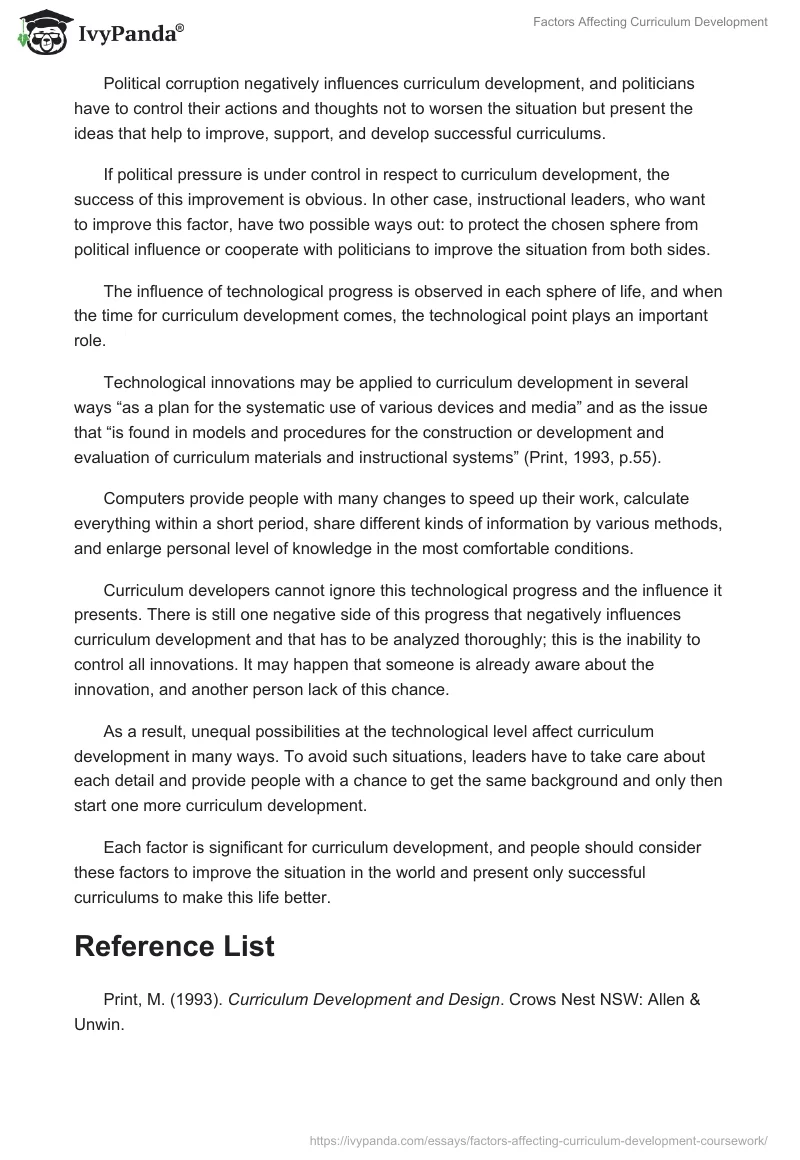Welcome to our essay sample! Here, you will find plenty of information about important factors influencing curriculum development, planning, and evaluation. Check it out to learn more about this subject!
Factors Influencing Curriculum Development: Essay Introduction
The term curriculum may be defined in many different ways: as a subject matter, or a set of rules and experiences, which help to choose the best way of development, or a plan that has to be followed.
Jon Wiles (2008) explains curriculum as “a set of desired goals or values that are activated through a development process and culminate in successful learning experiences for students” (p.2).
Curriculum development is an integral function that depends on numerous political, economical, social, technological, and psychological factors. Right now, political (political instability) and technological (variety of innovations) factors affective curriculum development will be evaluated.
Factors Affecting Curriculum Development: Main Body
Modern world continues progressing day by day: people present new inventions, demonstrate demands, change interests, forget about their primary functions, and try to follow their personal ideas. Each sphere undergoes considerable changes and causes the development of everything.
It is not a surprise that curriculum development becomes dependent on certain factors. Among the variety of these factors, such points like political instability and technological innovations are regarded as the most important ones.
Politics has a certain impact on all spheres of life, and instability of politics leads to instability in everyday life. It usually defines goals and content; political considerations need to be admitted while curriculum development; and political decisions may change the requirements for curriculum development.
If the sphere of politics cannot be called stable, it becomes hard to explain why some points within curriculum development have to be deleted, and new ideas should be considered.
Political corruption negatively influences curriculum development, and politicians have to control their actions and thoughts not to worsen the situation but present the ideas that help to improve, support, and develop successful curriculums.
If political pressure is under control in respect to curriculum development, the success of this improvement is obvious. In other case, instructional leaders, who want to improve this factor, have two possible ways out: to protect the chosen sphere from political influence or cooperate with politicians to improve the situation from both sides.
The influence of technological progress is observed in each sphere of life, and when the time for curriculum development comes, the technological point plays an important role.
Technological innovations may be applied to curriculum development in several ways “as a plan for the systematic use of various devices and media” and as the issue that “is found in models and procedures for the construction or development and evaluation of curriculum materials and instructional systems” (Print, 1993, p.55).
Computers provide people with many changes to speed up their work, calculate everything within a short period, share different kinds of information by various methods, and enlarge personal level of knowledge in the most comfortable conditions.
Curriculum developers cannot ignore this technological progress and the influence it presents. There is still one negative side of this progress that negatively influences curriculum development and that has to be analyzed thoroughly; this is the inability to control all innovations. It may happen that someone is already aware about the innovation, and another person lack of this chance.
Factors Influencing Curriculum Development: Essay Conclusion
As a result, unequal possibilities at the technological level affect curriculum development in many ways. To avoid such situations, leaders have to take care about each detail and provide people with a chance to get the same background and only then start one more curriculum development.
Each factor is significant for curriculum development, and people should consider these factors to improve the situation in the world and present only successful curriculums to make this life better.
Reference List
Print, M. (1993). Curriculum Development and Design. Crows Nest NSW: Allen & Unwin.
Wiles, J. (2009). Leading Curriculum Development. Thousand Oaks, CA: Corwin Press.

 4.00
4.00
